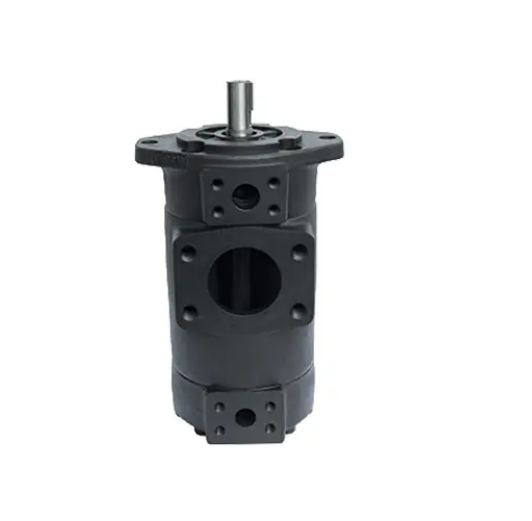The reasons for loose bearings and oil leakage from shaft seals are as follows:
A. During installation, the output shaft of the vane pump and the motor output shaft are not concentric (the motor output shaft is deformed, the coupling is not concentric, the positioning gap of the vane pump’s stop is too large, the installation fixing screw is not tightened, etc.) or they are against each other. When the vane pump is working, the radial force is too large or it jumps (irregular operation), which damages the bearings and shaft seals. If not handled in time, it will cause the pump core components to wear out and be scrapped.
B. The motor bearings have been worn. This phenomenon cannot be judged when the vane pump is not loaded. It is normal when it is no-load. During operation, the motor output shaft swings due to clearance, which drives the vane pump output shaft to swing and damages the bearings and shaft seals. .
C. Improper assembly. Because the vane pump operates at high speed, damage can easily occur if it is improperly assembled (improper installation or the shaft seal is misaligned).
D. Pressure oscillation means that the pressure of the system is unstable when the vane pump is working. As long as there is no abnormal noise from the oil pump, it should be a problem with the total pressure valve (relief valve). You should check whether the spool of the total pressure valve is Wear, and whether the damping is blocked by foreign matter; if the pressure oscillates due to wear of the pump core components, there will be abnormal noise when the oil pump is working.
E. System pressure drop means that the vane pump can reach a predetermined pressure when working, but the pressure will gradually drop during operation, causing the system to fail to work normally. If this phenomenon occurs in a newly installed pump, it should be caused by leakage of the system control valve or excessive oil temperature. If the above problem occurs again after a period of use, it is necessary to check whether the upper and lower oil distribution plates are worn (very smooth Wear), if the gap between the upper and lower oil distribution plates is too large, the oil temperature is too high (the mucosa cannot form a self-sealing oil), and leakage of the control valve will cause the system to lose pressure.
F. No pressure means that there is no pressure in the system when the vane pump is working. First, check whether there is hydraulic oil discharged from the vane pump. If not, check whether the working direction of the oil pump is correct and the coupling connection between the motor and the vane pump. Is it normal? Is the shaft positioning screw tightened and working? Is the blade unable to be thrown out due to the high viscosity of the hydraulic oil? Check whether the pump core rotor and blades are burned out and unable to work properly. Tighten the outlet pipe joint to see if There is hydraulic oil coming out. If there is, it proves that the pump is basically fine. The problem should be that the control valve is seriously leaking and the total pressure valve (relief valve) fails.
G. The reason why the system oil temperature is too high should be that the system pipes are too small, the pressure is too high, the hydraulic oil cannot be discharged in time, the cooling system does not meet the requirements, etc., which causes the vane pump to trap oil, which is reflected in the pump body and system oil temperature being too high. If it is high, increase the system pipeline or reduce the pump displacement according to the actual situation.
Post time: Jan-16-2024

